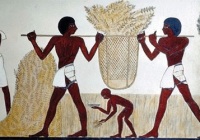Cover Photo: This is a photo of the excavations in area A at Chogha Golan, Iran. Credit: [Image courtesy of TISARP/University of Tübingen]
Topic: Fertile Crescent
The birth of agriculture has long been thought by scholars and scientists to have first emerged in the Levant and Mesopotamia, in the westen regions of what is known as the ancient Fertile Crescent.
Research related to excavations at a site in the foothills of the Zagros Mountains in present-day Iran, however, challenges that view, and argues for a more widespread development of the earliest agriculture across the Fertile Crescent. Simone Riehl from the University of Tübingen in Germany, along with colleagues from the Tübingen Senckenberg Center for Human Evolution and Paleoecology, have analyzed plant remains at the pre-pottery Neolithic site of Chogha Golan in Iran, and their results show that people were growing and grinding cereal grains like wheat and barley at the same time as their counterparts to the west, as early as 9,800 to 12,000 years ago.
Excavated in 2009 and 2010, archaeologists from the University of Tübingen and the Iranian Center for Archaeological Research uncovered artifacts, structures and plant remains that show that Chogha Golan's early inhabitants cultivated wild barley, wheat, lentil and grass peas at the location, with the first evidence of such plant management going back as far as 12,000 years ago.
"During the last few decades, numerous archaeological excavations were conducted in the Near East that led researchers to consider the possibility that multiple regions in the Fertile Crescent began cultivating cereal grains roughly at the same time, rather than just a single core area," Riehl said. "Plentiful findings of chaff remains of the cereals indicate that people processed their harvest within the sites they were living in. Mortars and grinding stones may have been used for turning the grain into some kind of bulgur or flour, which may have been further processed either by cooking or roasting."
The Chogha Golan site represents the earliest record of long-term plant management in Iran, according to the researchers.
These findings suggest that essentially simultaneous processes led to the management of wild plants and the domestication of cereal grains across most of the Fertile Crescent.
"For some time, the emergence of agriculture in Iran was considered as part of a cultural transfer from the west," Riehl said. "This opinion was, however, mostly based on the lack of information from Iranian sites. We meanwhile assume that key areas for emerging domestication existed over the whole Fertile Crescent, and that there were several locations where domesticated species evolved as a result of cultivation by local human groups."
The authors note, however, that it may not have been as simple as simultaneous emergence at multiple locations and that interregional exchanges of ideas and cultigens may have played a role.
The study report is published in the July 5th issue of the journal Science.
Original article:
popular archaeology

This photo shows the architecture and grinding equipment from excavation area A in Chogha Golan, Iran. Credit: [Image courtesy of TISARP/University of Tübingen]





The earliest record of long-term plant management found in Iran– that’s an interesting discovery. Thanks you for sharing the information!
LikeLike